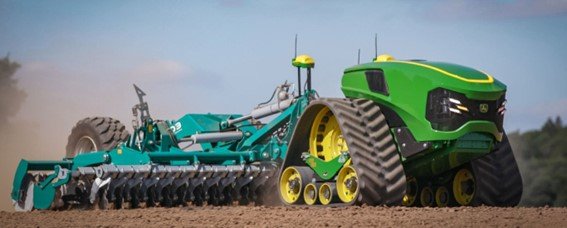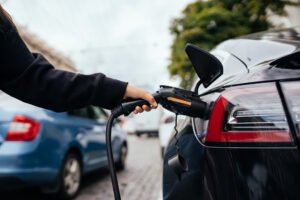Electric mobility (electromobility) is a reality that is rapidly gaining importance in passenger vehicles, buses and micro mobility. In the specific case of the agricultural industry there were also significant advances. The equipment currently used in agriculture is very likely, as in passenger cars, to reach its limit of optimization with current technology. For this particular reason, electrification is gaining importance, apart from the environmental benefits, and already many manufacturing companies of agricultural equipment manufacturers are investing resources to develop and test electric motors and batteries to be able to replace conventional propulsion systems in the future.
The duration and autonomy of the batteries in adverse conditions and environments is undoubtedly a challenge from a technological point of view, which can find a temporary solution in the hybrid vehicles.
On the other hand, the agricultural industry has been producing its own electricity for a long time from renewable energy systems, such as photovoltaics, which would represent an advantage since they would have greater autonomy and control over their costs and energy capacity.
Does electrification have a future in the agricultural area? Would it be possible to use electric or hybrid tractors?
According to some experts, a hybrid tractor could barely take advantage from the «recovery» function to recharge the batteries, generating small efficiency benefits which does not imply that it could be used as a transition technology.
However, pure electrical machinery could offer considerable advantages over to a Diesel combustion engine, given that a larger amount of compact machinery could be designed with greater performance and lower weight, in addition to the environmental benefits we already know.
Recently, John Deere introduced a compact electric tractor that can cut more than 10,000 m2 of grass with a battery charge that lasts 4.5 hours. In addition to a high performance for this activity, customers benefit from very low maintenance costs. Potential applications are the ones that require low levels of noise and free-reemissions operations. The challenge lies in being able to meet high power requirements and high long runs for more complex tasks. Tractors, for example, are used for many hours in a row and require a lot of power and, therefore, energy. Additionally, battery charging times are still relatively long, which represents another obstacle.
In 2011 at Agritechnica in Hannover, a hydrogen-powered tractor was presented, with fuel cells that deliver greater power, so hydrogen could undoubtedly become a solution and the formula to overcome all obstacles.
An electric and autonomous tractor, a reality that is coming…
The new concept of an electric and autonomous tractor has already been presented by John Deere. It consists in a very compact electric drive unit with a total power of 500 kW and can be equipped with wheels or tracks. Thanks to its electric drive, there are no operational emissions and noise levels are extremely low. As we already mentioned, the advantages include low deterioration and low maintenance costs as well.
The benefits of electrification in agriculture not only represent an alternative to the motor internal combustion. It will also play an important role in the sustainability of the agricultural ecosystem, including care for the environment and animal welfare since a propulsion system wich is emission free and silent has benefits for the health of the passengers, animals (considerably reduces stress levels of those animals wich are sensitive to noise) and humans. Additionally, any type of contaminant that may affect crops -regarding internal combustion- would be avoided.

For these benefits to be capitalized, multiple challenges must be overcome, as well as than other industries that are making an advance in electrification:
• Improve vehicle architecture and thermal management of electrical components.
• Implement monitoring and diagnosis systems.
• Evaluate the impact of battery volume, weight and cost.
• Achieve reliability and performance of electrical components in a rural environment (e.g.vibration, level, dirt, etc.)
• Develop a supply/value chain and technical support not yet trained;
• Develop an infrastructure around the electrical machine, such as charging or cables systems.
In terms of results and application, it is still in a very experimental stage. Eventually, electrical energy sources will coexist with conventional engine, power take-off, hydraulic and traction.
Even though electric motors have been used in vehicles and other applications for a long time, there is still need for further development in hard work applications. Compact size, energy efficiency over a wide operating area, thermal management, its control and reliability are important aspects to solve. Furthermore, the electrical energy storage is a key factor for the success of electrification in the agro.
Despite this, it is important to understand that diesel engine, biodiesel and other conventional fuels will continue to play an important role for a long time because they are a robust, reliable and well-known option at a competitive price.
For electromobility to continue developing advances in agriculture, it is essential to maintain investments in R&D and evaluate new concepts to identify the benefits and best solution for farmers.
It is important to understand that electrification is going to be an enabling factor for new vehicle architecture to meet the challenges of the future. Other mportant factors such as regulations, standards, incentives and charging infrastructure will play a fundamental role in determining the adoption of electrification. The creation of
infrastructure will require support of government subsidies for farmers (such as they already exist for other fuels) in order to implement a complete vision of smart agriculture 4.0.
Conclusion
As long as there are no greater restrictions on CO2 emissions and technological advances to overcome the current challenges, it seems that tractors and other agricultural machinery will continue to run on fossil diesel fuel as there is no real need. In the best case scenario, biofuel or methane from biogas plants could be a
option. The electrification trend is still a long way from achieving any kind of progress or receive accepted implementation in massive ways, however there are opportunities for the future once these challenges have been resolved.
At MIRAIICO we support transformation and prepare companies for the digital and global future. www.miraiico.com.ar | ebucciarelli@miraiico.com





